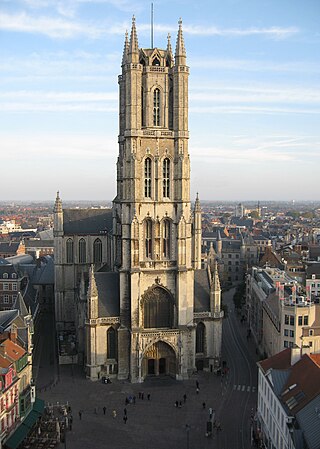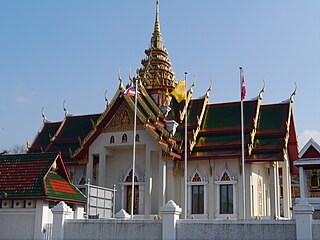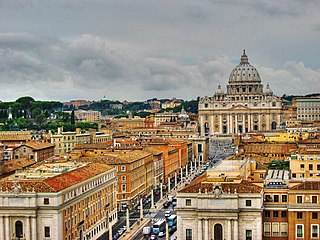
A monastery is a building or complex of buildings comprising the domestic quarters and workplaces of monastics, monks or nuns, whether living in communities or alone (hermits). A monastery generally includes a place reserved for prayer which may be a chapel, church, or temple, and may also serve as an oratory, or in the case of communities anything from a single building housing only one senior and two or three junior monks or nuns, to vast complexes and estates housing tens or hundreds. A monastery complex typically comprises a number of buildings which include a church, dormitory, cloister, refectory, library, balneary and infirmary, and outlying granges. Depending on the location, the monastic order and the occupation of its inhabitants, the complex may also include a wide range of buildings that facilitate self-sufficiency and service to the community. These may include a hospice, a school, and a range of agricultural and manufacturing buildings such as a barn, a forge, or a brewery.

Hinduism in Southeast Asia had a profound impact on the region's cultural development and its history. As the Indic scripts were introduced from India, people of Southeast Asia entered the historical period by producing their earliest inscriptions around the 1st to 5th century CE. Today, Hindus in Southeast Asia are mainly Overseas Indians and Balinese. There are also Javanese and Balamon Cham minority in Cambodia and south central Vietnam who also practice Hinduism.

Christianity is the largest religion in Belgium, with the Catholic Church representing the largest community, though it has experienced a significant decline since the 1950s. Belgium's policy separates the state from the churches, and freedom of religion of the citizens is guaranteed by the country's constitution.
Buddhism in Nepal started spreading since the reign of Ashoka through Indian and Tibetan missionaries. The Kirati people were the first people in Nepal who embraced Gautama Buddha’s teachings, followed by the Licchavis and Newar people. Buddha was born in Lumbini in the Shakya Kingdom. Lumbini lies in present-day Rupandehi District, Lumbini zone of Nepal. Buddhism is the second-largest religion in Nepal. According to 2001 census, 10.74% of Nepal's population practiced Buddhism, consisting mainly of Tibeto-Burman-speaking ethnicities and the Newar. However, in the 2011 census, Buddhists made up just 9% of the country's population.

Hinduism is the Fourth-largest religion in Myanmar, being practised by 1.7% of the population of Myanmar. Hinduism is practised by about 890,000 people in Myanmar, and has been influenced by elements of Buddhism, with many Hindu temples in Myanmar housing statues of the Buddha. There are also a large population of Hindus in which the Myanmar Tamils and minority Bengali Hindus having the biggest population share.

A matha, also written as math, muth, mutth, mutt, or mut, is a Sanskrit word that means 'institute or college', and it also refers to a monastery in Hinduism. An alternative term for such a monastery is adheenam. The earliest epigraphical evidence for mathas related to Hindu-temples comes from the 7th to 10th century CE.

Religion in Russia is diverse, with Orthodox Christianity being the most widely professed faith, but with significant minorities of non-religious people and adherents of other faiths. A 1997 law on religion recognises the right to freedom of conscience and creed to all the citizenry, the spiritual contribution of Orthodox Christianity to the history of Russia, and respect to "Christianity, Islam, Buddhism, Judaism and other religions and creeds which constitute an inseparable part of the historical heritage of Russia's peoples", including ethnic religions or paganism, either preserved, or revived. According to the law, any religious organisation may be recognised as "traditional", if it was already in existence before 1982, and each newly founded religious group has to provide its credentials and re-register yearly for fifteen years, and, in the meantime until eventual recognition, stay without rights.

Buddhism is a minority religion in Switzerland. According to the 2000 census, 21,305 Swiss residents self-identified as Buddhists. About a third of them were born in Thailand.

Buddhism in Italy is the third most spread religion, next to Christianity and Islam. According to Caritas Italiana, in the country there are 160,000 Buddhists, that is to say the 0.3% of the total population.

Hinduism is a minority religion practised by 0.6% of the population of Switzerland. Approximately 90% of Hindu adherents are foreign-born, and about a third of them have the status of refugee or asylum seeker. The Sri Sivasubramaniar Temple, located in the Sihl Valley in Adliswil, is the most famous and oldest Hindu temple in Switzerland, the Arulmihu Sivan Temple located in Glattbrugg is dedicated to Shiva, and the latest foundation is the Sri Vishnu Thurkkai Amman Temple in Dürnten in 2010.

Religion in Italy has been historically characterised by the dominance of the Catholic Church since the East–West Schism, but, over the years, due to immigration, the influx of Muslims, Orthodox Christians, Protestants, Buddhists and Hindus, as well as proselytism, religious pluralism has increased. Italy also features a pre-Christian Jewish community and one of the largest shares of Jehovah's Witnesses in the world.
The Italian Hindu Union is an association representing Hinduism in Italy.
Swami Yogananda Giri is a Hindu religious figure in Italy. He was the founder of the Unione Induista Italia.

Religion in India is characterised by a diversity of religious beliefs and practices. Throughout India's history, religion has been an important part of the country's culture and the Indian subcontinent is the birthplace of four of the world's major religions, namely, Buddhism, Hinduism, Jainism, and Sikhism, which are collectively known as native Indian religions or Dharmic religions and represent approx. 83% of the total population of India.

Religion in the European Union is diverse. The largest religion in the EU is Christianity, which accounted for 72.8% of EU population as of 2018. Smaller groups include those of Islam, Buddhism, Judaism, Hinduism, and some East Asian religions, most concentrated in Germany and France. Also present are revival movements of pre-Christianity European folk religions including Heathenism, Rodnovery, Romuva, and Druidry.
The United Nations categorizes Bangladesh as a moderate democratic Muslim country. Sunni Islam is the largest and most dominant religion practiced in the country. In the Constitution of Bangladesh, Islam is referred to twice in the introduction and Part I of the constitution. The document begins with the Islamic phrase Bismillahir Rahmanir Raheem which in English is translated as "In the name of Allah, the Beneficent, the Merciful" and article (2A) declares that:"Islam is the state religion of the republic".
Bhutan is a Buddhist country by constitution and Buddhism plays a vital role in the country.
Myanmar (Burma) is a Buddhist majority country with a significant minority of Christians and other groups residing in the country.

Buddhism is the largest religion in Thailand, practised by roughly 94% of the population. The Thai Constitution does not indicate any state religion, but promotes Buddhism, while guaranteeing religious freedom for all Thai citizens. Many other people, especially among the Isan ethnic group, practise Tai folk religions. A significant minority Muslim population, mostly constituted by Thai Malays, is present especially in the southern regions. Thai law officially recognizes five religions: Buddhism, Islam, Christianity, Hinduism, and Sikhism.

The Italian Buddhist Union is an association representing Buddhism in Italy.


















